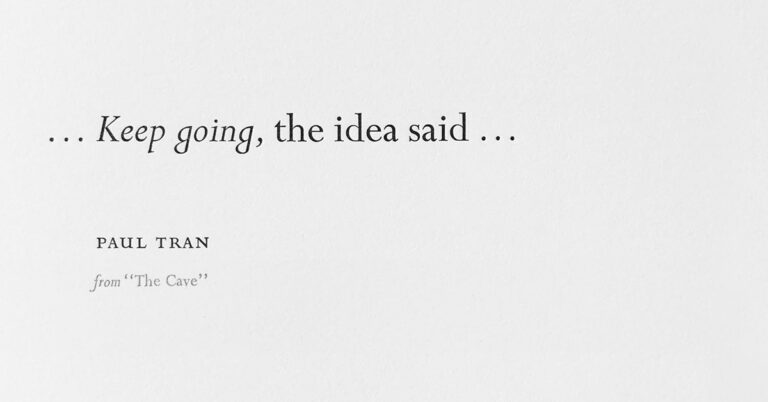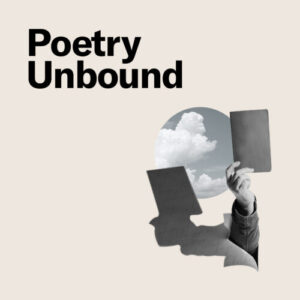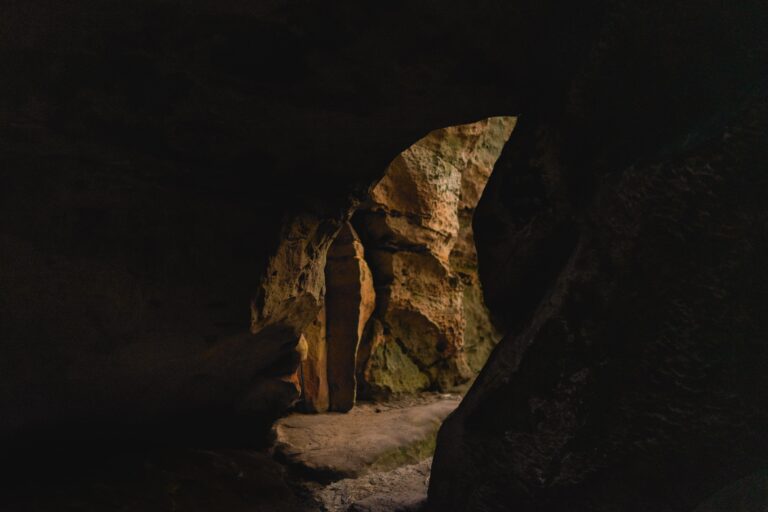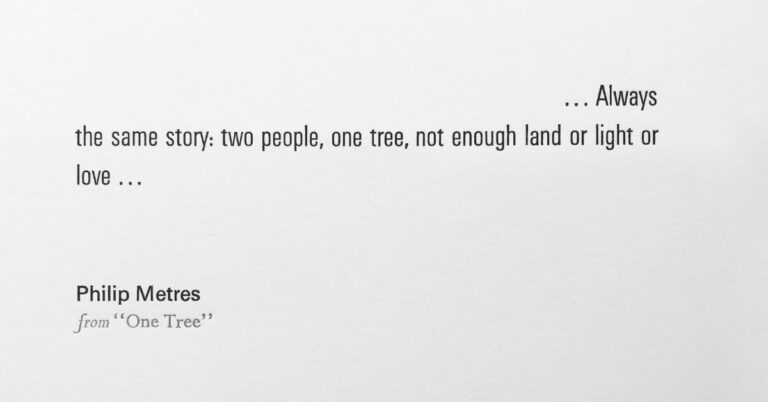Paul Tran
The Cave
What have you had to explore on your own? What, or who, helped?
This poem explores the archetype of the cave — a cave that calls, a cave that contains secrets and perhaps even information. “Someone standing at the mouth had / the idea to enter. To go further / than light or language could / go.” The poem manages — at once — to convey the bravery of exploration and the solitude and possibility that can accompany such journeys.

Image by Expedition Press/Expedition Press, © All Rights Reserved.
Guest

Paul Tran is the recipient of a Ruth Lilly and Dorothy Sargent Rosenberg Fellowship from the Poetry Foundation and a Discovery/Boston Review Poetry Prize. Their work has appeared in The New Yorker, Poetry Magazine, Good Morning America, NYLON, and elsewhere, including the RZA-directed movie Love Beats Rhymes alongside Azealia Banks, Common, and Jill Scott.
Transcript
Pádraig Ó Tuama, host: My name is Pádraig Ó Tuama, and I feel a great debt of gratitude to poets. I read contemporary poets as well as historical poets, and read poems from antiquity in Irish, where nobody really knows who the poet was. And I’m so full of gratitude, because, inasmuch as poetry can feel like a solitary journey while I’m by myself, nonetheless, when you read old poetry you realize, people have been asking these questions for thousands of years. And even though I’m alone, I’m not alone.
[music: “Praise the Rain” by Gautam Srikishan]
Ó Tuama: “The Cave” by Paul Tran:
“Someone standing at the mouth had
the idea to enter. To go further
than light or language could
go. As they followed
the idea, light and language followed
like two wolves—panting, hearing themselves
panting. A shapeless scent
in the damp air …
Keep going, the idea said.
Someone kept going. Deeper and deeper, they saw
others had been there. Others had left
objects that couldn’t have found their way
there alone. Ocher-stained shells. Bird bones. Grounded
hematite. On the walls,
as if stepping into history, someone saw
their purpose: cows. Bulls. Bison. Deer. Horses—
some pregnant, some slaughtered.
The wild-
life seemed wild and alive, moving
when someone moved, casting their shadows
on the shadows stretching
in every direction. Keep going,
the idea said again. Go …
Someone continued. They followed the idea so far inside that
outside was another idea.”
[music: “At Dusk” by Gautam Srikishan]
Ó Tuama: The image of cave has transfixed people’s archetypal imaginations. You can think of Plato’s cave, and you can think of all these ways within which we think about cave-dwelling peoples in antiquity. But this image of cave isn’t just for the past. This image of cave is something that calls us into continued, further exploration — to go further than light or language could go. They’re like inner space, and that operates physically, as well as operates metaphorically, for people to think about going on a journey of bravery within themselves, or trying to discover something of their own unconscious or their own underground.
And the assertion, I think, of Paul Tran in this poem, I think what they’re saying is that we need to continue to go into new caves or caves that we think are new, in order to mine the possibility for what it can mean to be human, together, in these brave explorations.
This poem is so profoundly respectful of the creative and intellectual imaginations that have come before, that have made their own brave and solitary journeys into the cave of ideas, or into the cave of exploration of language or considerations, because it speaks about the objects that were left there before or the paintings on the wall, and suddenly, how, in the flickering light of your own candle, you become up on that wall, too, moving around and living, just in this changing light of a candle.
And I think that is such a deeply respectful approach within the poem. And Paul Tran, I think, is challenging a certain idea that people might have, that there’s something new to be discovered. Paul Tran is saying, no — this stuff’s been explored before, and maybe it has been deliberately forgotten. Or maybe somebody has denied it. And we are asserting here that we are part of a great tribe of people who have done this exploration before and, perhaps, whose discoveries have been denied or silenced.
[music: “Skittle Kid Kodi” by Blue Dot Sessions]
Ó Tuama: We speak about caves in strange ways. We speak about the mouth of a cave. Sometimes, people might speak about the belly of a cave, or if you speak about a person who’s been part of an endeavor and then say, “Oh, they caved in.” We can see ways within which this usage of the word “cave” enters into our language. And then, when we hear of the gendered “caveman,” something that’s queered in this poem, we can think about, well, why do we speak about caveman? Just that it trips off the tongue with such repeated and received familiarity. What about “cave person” or “cave woman”? This poem is very, very careful about pronouns: “someone,” “they.”
Who is this someone? We know nothing about them, really, except their curiosity and determination and continuation into a cave. And they go further than light goes and further than language goes. And they’re led by the idea, this someone is. And so, by doing, they recognize that others have gone before them — because they find shells and bones and grounded stones, and images on the wall of life outside.
And then, I think, this poem is also inviting us to think, what is the idea that I’m being called into in language, to bring my own light and to discover who has gone before me? Who are the ancestors of this brave new exploration that’s new for me? And who might I be able to turn to, to see the artifacts that they left behind, as they asked questions that I’m now asking myself, feeling alone but discovering ways within which people before me have already taken this quest and might have some wisdom to share to me and that I have some wisdom to take?
[music: “At Dusk” by Gautam Srikishan]
Ó Tuama: There’s a technique of echo. The whole way throughout the poem you see this, and “light” and “language” being echoed early, and “panting, hearing themselves / panting.” “Keep going,” someone keeps going; “deeper and deeper.” Others/others, some/some, life/life — “life seemed wild and alive, moving / when someone moved, casting their shadows / on the shadows.” And so this poem is in conversation with itself. They function like an echo.
And then finally, at the end of the poem, we hear the strange echo of inside/outside, and this vast perspective change that’s happening, and the exchange of ideas that seems to need to happen between the ideas of the outside of the inside and the ideas of the inside of the outside. And this poem is echoing itself like a vast cavern does and inviting whichever one of us is exploring the cave to be in conversation with the echoes, as well as to be in conversation with people who’ve taken this journey before, as well as to be in conversation with people in other caves of exploration.
Joseph Campbell has said, “Where you stumble, there lies your treasure. The very cave you are afraid to enter turns out to be the source of what you were looking for. The damned thing in the cave that was so dreaded has become the center”. And I think Paul Tran is responding to Joseph Campbell in the unconscious, and Paul Tran is taking something that is of human archetype and inviting us to go where they have gone and to be led by them, deeper into the cave, deeper into the recognition of ancestors, and deeper into the possibility that an idea might be found there that can save us.
[music: “Into the Earth” by Gautam Srikishan]
“The Cave” by Paul Tran:
“Someone standing at the mouth had
the idea to enter. To go further
than light or language could
go. As they followed
the idea, light and language followed
like two wolves—panting, hearing themselves
panting. A shapeless scent
in the damp air …
Keep going, the idea said.
Someone kept going. Deeper and deeper, they saw
others had been there. Others had left
objects that couldn’t have found their way
there alone. Ocher-stained shells. Bird bones. Grounded
hematite. On the walls,
as if stepping into history, someone saw
their purpose: cows. Bulls. Bison. Deer. Horses—
some pregnant, some slaughtered.
The wild-
life seemed wild and alive, moving
when someone moved, casting their shadows
on the shadows stretching
in every direction. Keep going,
the idea said again. Go …
Someone continued. They followed the idea so far inside that
outside was another idea.”
[music: “Praise the Rain” by Gautam Srikishan]
Lily Percy: “The Cave” by Paul Tran was originally published in Poetry Magazine. Thank you to Paul for giving us permission to use their poem. Read it on our website, at onbeing.org.
Poetry Unbound is Chris Heagle, Erin Colasacco, Serri Graslie, Eddie Gonzalez, Lilian Vo, Christiane Wartell, Karen Navarre, Karyn Towey, Sue Ariza, and me, Lily Percy. Our music is composed and provided by Gautam Srikishan and Blue Dot Sessions. This podcast is produced by On Being Studios, which is located on Dakota land. We also produce other podcasts you might enjoy, like On Being with Krista Tippett, Becoming Wise, and This Movie Changed Me — find those wherever you like to listen or visit us at onbeing.org to find out more.










Reflections